Protein Synthesis and Nucleic Acids in Human Genetics
VerifiedAdded on 2023/01/06
|9
|2234
|96
AI Summary
This document provides an overview of protein synthesis and nucleic acids in human genetics. It explains the role of DNA, mRNA, tRNA, and ribosomes in protein synthesis. It also discusses the process of genetic engineering and its applications. Additionally, it explores the causes of Down's syndrome and the genetic tests used to diagnose it. The document concludes with a discussion on the bioethical debates surrounding gene editing technology.
Contribute Materials
Your contribution can guide someone’s learning journey. Share your
documents today.

Human Genetics 1
HUMAN GENETICS
BY ( )
Class (Course)
Professor (Tutor)
School (University)
City and State
Date
HUMAN GENETICS
BY ( )
Class (Course)
Professor (Tutor)
School (University)
City and State
Date
Secure Best Marks with AI Grader
Need help grading? Try our AI Grader for instant feedback on your assignments.
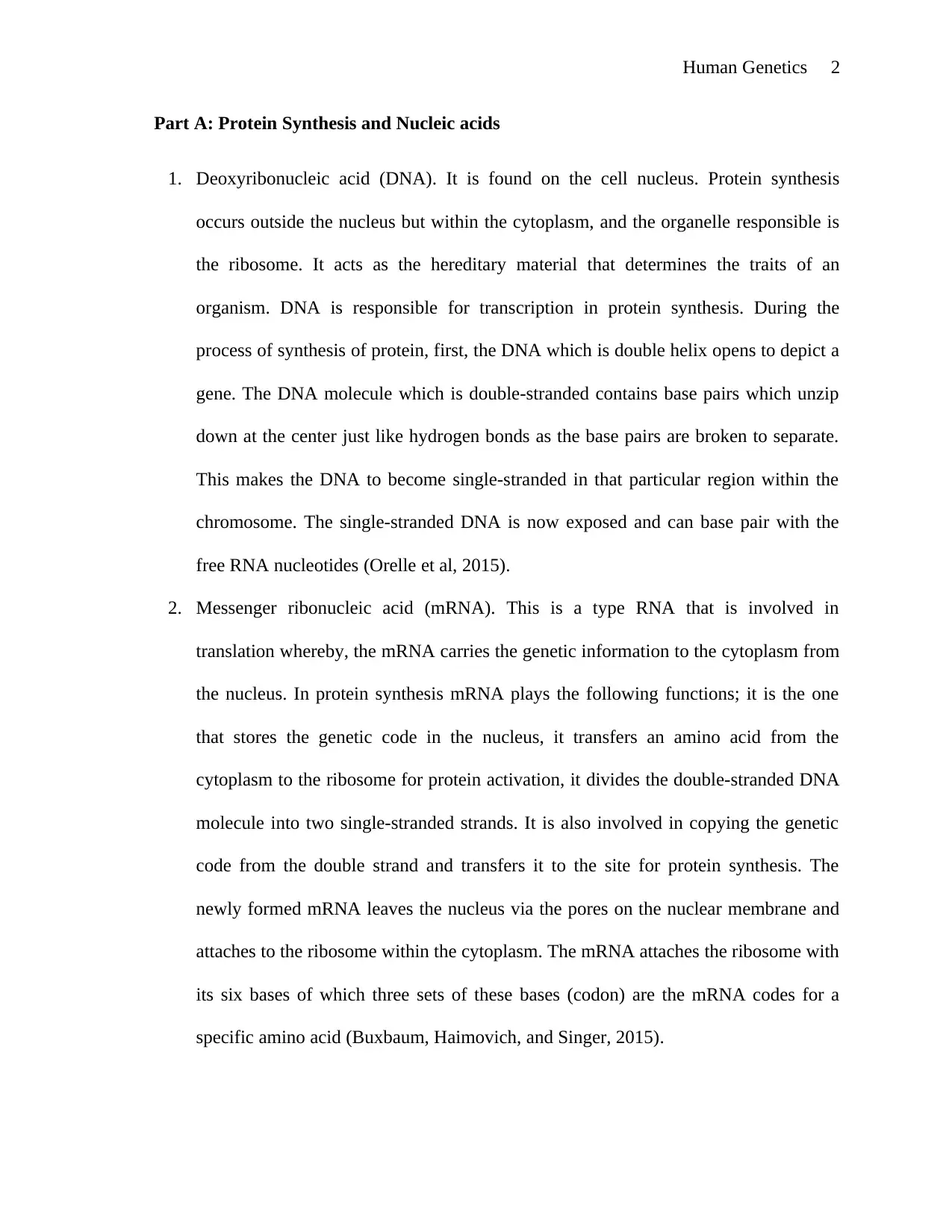
Human Genetics 2
Part A: Protein Synthesis and Nucleic acids
1. Deoxyribonucleic acid (DNA). It is found on the cell nucleus. Protein synthesis
occurs outside the nucleus but within the cytoplasm, and the organelle responsible is
the ribosome. It acts as the hereditary material that determines the traits of an
organism. DNA is responsible for transcription in protein synthesis. During the
process of synthesis of protein, first, the DNA which is double helix opens to depict a
gene. The DNA molecule which is double-stranded contains base pairs which unzip
down at the center just like hydrogen bonds as the base pairs are broken to separate.
This makes the DNA to become single-stranded in that particular region within the
chromosome. The single-stranded DNA is now exposed and can base pair with the
free RNA nucleotides (Orelle et al, 2015).
2. Messenger ribonucleic acid (mRNA). This is a type RNA that is involved in
translation whereby, the mRNA carries the genetic information to the cytoplasm from
the nucleus. In protein synthesis mRNA plays the following functions; it is the one
that stores the genetic code in the nucleus, it transfers an amino acid from the
cytoplasm to the ribosome for protein activation, it divides the double-stranded DNA
molecule into two single-stranded strands. It is also involved in copying the genetic
code from the double strand and transfers it to the site for protein synthesis. The
newly formed mRNA leaves the nucleus via the pores on the nuclear membrane and
attaches to the ribosome within the cytoplasm. The mRNA attaches the ribosome with
its six bases of which three sets of these bases (codon) are the mRNA codes for a
specific amino acid (Buxbaum, Haimovich, and Singer, 2015).
Part A: Protein Synthesis and Nucleic acids
1. Deoxyribonucleic acid (DNA). It is found on the cell nucleus. Protein synthesis
occurs outside the nucleus but within the cytoplasm, and the organelle responsible is
the ribosome. It acts as the hereditary material that determines the traits of an
organism. DNA is responsible for transcription in protein synthesis. During the
process of synthesis of protein, first, the DNA which is double helix opens to depict a
gene. The DNA molecule which is double-stranded contains base pairs which unzip
down at the center just like hydrogen bonds as the base pairs are broken to separate.
This makes the DNA to become single-stranded in that particular region within the
chromosome. The single-stranded DNA is now exposed and can base pair with the
free RNA nucleotides (Orelle et al, 2015).
2. Messenger ribonucleic acid (mRNA). This is a type RNA that is involved in
translation whereby, the mRNA carries the genetic information to the cytoplasm from
the nucleus. In protein synthesis mRNA plays the following functions; it is the one
that stores the genetic code in the nucleus, it transfers an amino acid from the
cytoplasm to the ribosome for protein activation, it divides the double-stranded DNA
molecule into two single-stranded strands. It is also involved in copying the genetic
code from the double strand and transfers it to the site for protein synthesis. The
newly formed mRNA leaves the nucleus via the pores on the nuclear membrane and
attaches to the ribosome within the cytoplasm. The mRNA attaches the ribosome with
its six bases of which three sets of these bases (codon) are the mRNA codes for a
specific amino acid (Buxbaum, Haimovich, and Singer, 2015).

Human Genetics 3
3. Transfer ribonucleic acid (tRNA). During protein synthesis, the tRNA puts the amino
acids into a position in the ribosome. The major role of tRNA during the construction
of protein is that it decodes a particular mRNA codon through its anticodon end and
transfers the specific amino acid into the end site of the ribosome. The tRNA which
exists throughout the cell cytoplasm has three bases on one side and the other side,
and amino acid is attached. Thre three tRNA base sequence also called the anticodon;
they specifically determine the amino acid to be carried on the opposite side on a
particular tRNA molecule. When several tRNA molecules are involved in encoding
for their specific mRNA, they build up a chain of amino acids (polypeptide), and this
leads to the creation of a protein in the original mRNA strand (Orelle et al, 2015).
4. Ribosome. The ribosome aligns both the triplet anticodon of tRNA and the codon of
the mRNA with enabling them to pair up correctly. If the codon of the mRNA fails to
pair up correctly with the anticodon of the tRNA, the ribosome eliminates the tRNA
and brings in line another tRNA until it got the one that matches the exact mRNA.
When the ribosome finds the exact tRNA to match the mRNA, the ribosome then
detaches the amino acid on the tRNA by attaching it to itself. The next three bases of
the codon move into the position where the previous codon was, and the process of
finding the correct tRNA starts again. The repeats of these steps eventually result in a
chain of amino acids on the ribosomes forming a protein (Brar, and Weissman, 2015).
Part B: Genetic Engineering
1c. Through the technology of recombinant DNA, the scientist made it possible to
genetically make a recombinant microorganism that can produce a protein that is encoded
by the human gene (Maxmen, 2017). The plasmid of a bacterium is genetically modified
3. Transfer ribonucleic acid (tRNA). During protein synthesis, the tRNA puts the amino
acids into a position in the ribosome. The major role of tRNA during the construction
of protein is that it decodes a particular mRNA codon through its anticodon end and
transfers the specific amino acid into the end site of the ribosome. The tRNA which
exists throughout the cell cytoplasm has three bases on one side and the other side,
and amino acid is attached. Thre three tRNA base sequence also called the anticodon;
they specifically determine the amino acid to be carried on the opposite side on a
particular tRNA molecule. When several tRNA molecules are involved in encoding
for their specific mRNA, they build up a chain of amino acids (polypeptide), and this
leads to the creation of a protein in the original mRNA strand (Orelle et al, 2015).
4. Ribosome. The ribosome aligns both the triplet anticodon of tRNA and the codon of
the mRNA with enabling them to pair up correctly. If the codon of the mRNA fails to
pair up correctly with the anticodon of the tRNA, the ribosome eliminates the tRNA
and brings in line another tRNA until it got the one that matches the exact mRNA.
When the ribosome finds the exact tRNA to match the mRNA, the ribosome then
detaches the amino acid on the tRNA by attaching it to itself. The next three bases of
the codon move into the position where the previous codon was, and the process of
finding the correct tRNA starts again. The repeats of these steps eventually result in a
chain of amino acids on the ribosomes forming a protein (Brar, and Weissman, 2015).
Part B: Genetic Engineering
1c. Through the technology of recombinant DNA, the scientist made it possible to
genetically make a recombinant microorganism that can produce a protein that is encoded
by the human gene (Maxmen, 2017). The plasmid of a bacterium is genetically modified
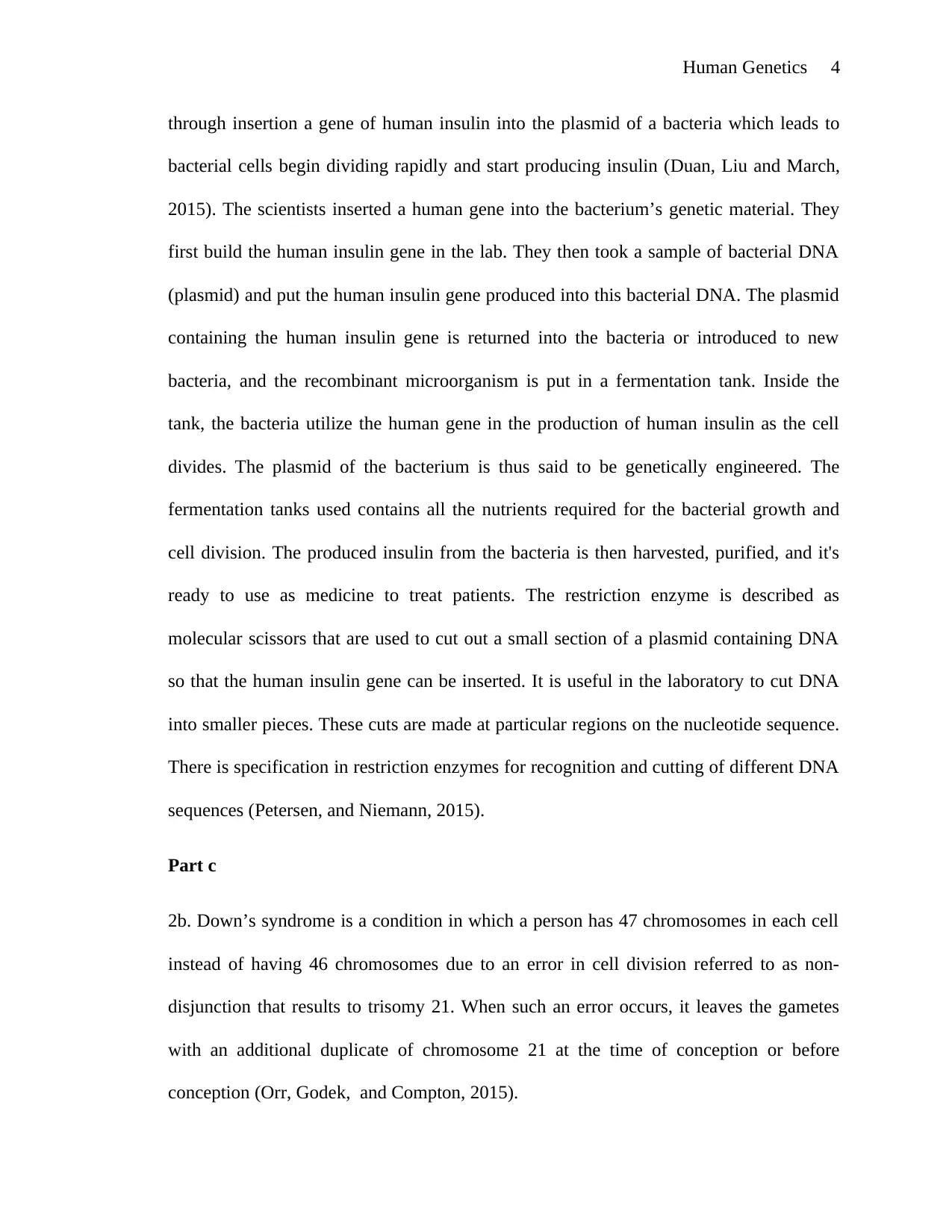
Human Genetics 4
through insertion a gene of human insulin into the plasmid of a bacteria which leads to
bacterial cells begin dividing rapidly and start producing insulin (Duan, Liu and March,
2015). The scientists inserted a human gene into the bacterium’s genetic material. They
first build the human insulin gene in the lab. They then took a sample of bacterial DNA
(plasmid) and put the human insulin gene produced into this bacterial DNA. The plasmid
containing the human insulin gene is returned into the bacteria or introduced to new
bacteria, and the recombinant microorganism is put in a fermentation tank. Inside the
tank, the bacteria utilize the human gene in the production of human insulin as the cell
divides. The plasmid of the bacterium is thus said to be genetically engineered. The
fermentation tanks used contains all the nutrients required for the bacterial growth and
cell division. The produced insulin from the bacteria is then harvested, purified, and it's
ready to use as medicine to treat patients. The restriction enzyme is described as
molecular scissors that are used to cut out a small section of a plasmid containing DNA
so that the human insulin gene can be inserted. It is useful in the laboratory to cut DNA
into smaller pieces. These cuts are made at particular regions on the nucleotide sequence.
There is specification in restriction enzymes for recognition and cutting of different DNA
sequences (Petersen, and Niemann, 2015).
Part c
2b. Down’s syndrome is a condition in which a person has 47 chromosomes in each cell
instead of having 46 chromosomes due to an error in cell division referred to as non-
disjunction that results to trisomy 21. When such an error occurs, it leaves the gametes
with an additional duplicate of chromosome 21 at the time of conception or before
conception (Orr, Godek, and Compton, 2015).
through insertion a gene of human insulin into the plasmid of a bacteria which leads to
bacterial cells begin dividing rapidly and start producing insulin (Duan, Liu and March,
2015). The scientists inserted a human gene into the bacterium’s genetic material. They
first build the human insulin gene in the lab. They then took a sample of bacterial DNA
(plasmid) and put the human insulin gene produced into this bacterial DNA. The plasmid
containing the human insulin gene is returned into the bacteria or introduced to new
bacteria, and the recombinant microorganism is put in a fermentation tank. Inside the
tank, the bacteria utilize the human gene in the production of human insulin as the cell
divides. The plasmid of the bacterium is thus said to be genetically engineered. The
fermentation tanks used contains all the nutrients required for the bacterial growth and
cell division. The produced insulin from the bacteria is then harvested, purified, and it's
ready to use as medicine to treat patients. The restriction enzyme is described as
molecular scissors that are used to cut out a small section of a plasmid containing DNA
so that the human insulin gene can be inserted. It is useful in the laboratory to cut DNA
into smaller pieces. These cuts are made at particular regions on the nucleotide sequence.
There is specification in restriction enzymes for recognition and cutting of different DNA
sequences (Petersen, and Niemann, 2015).
Part c
2b. Down’s syndrome is a condition in which a person has 47 chromosomes in each cell
instead of having 46 chromosomes due to an error in cell division referred to as non-
disjunction that results to trisomy 21. When such an error occurs, it leaves the gametes
with an additional duplicate of chromosome 21 at the time of conception or before
conception (Orr, Godek, and Compton, 2015).
Secure Best Marks with AI Grader
Need help grading? Try our AI Grader for instant feedback on your assignments.
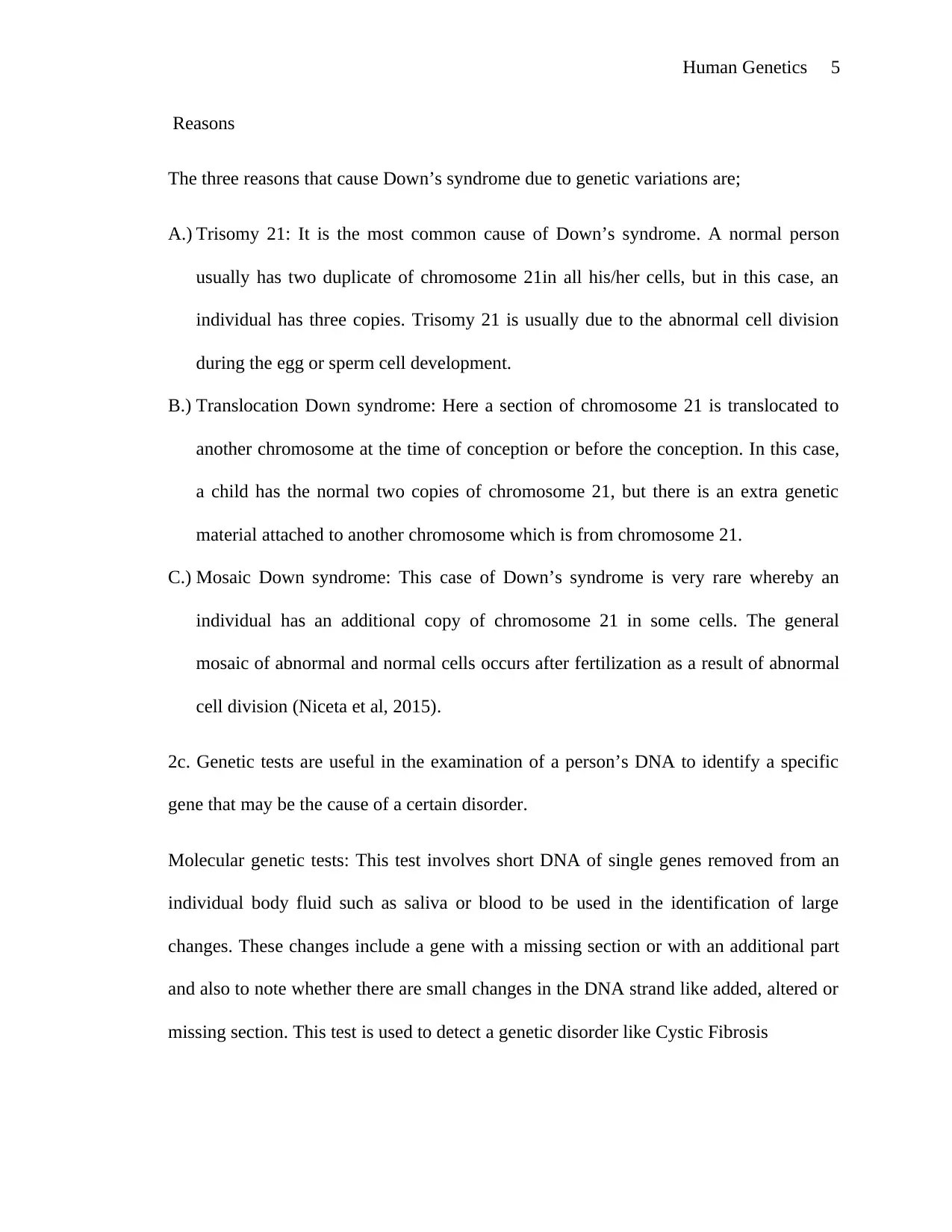
Human Genetics 5
Reasons
The three reasons that cause Down’s syndrome due to genetic variations are;
A.) Trisomy 21: It is the most common cause of Down’s syndrome. A normal person
usually has two duplicate of chromosome 21in all his/her cells, but in this case, an
individual has three copies. Trisomy 21 is usually due to the abnormal cell division
during the egg or sperm cell development.
B.) Translocation Down syndrome: Here a section of chromosome 21 is translocated to
another chromosome at the time of conception or before the conception. In this case,
a child has the normal two copies of chromosome 21, but there is an extra genetic
material attached to another chromosome which is from chromosome 21.
C.) Mosaic Down syndrome: This case of Down’s syndrome is very rare whereby an
individual has an additional copy of chromosome 21 in some cells. The general
mosaic of abnormal and normal cells occurs after fertilization as a result of abnormal
cell division (Niceta et al, 2015).
2c. Genetic tests are useful in the examination of a person’s DNA to identify a specific
gene that may be the cause of a certain disorder.
Molecular genetic tests: This test involves short DNA of single genes removed from an
individual body fluid such as saliva or blood to be used in the identification of large
changes. These changes include a gene with a missing section or with an additional part
and also to note whether there are small changes in the DNA strand like added, altered or
missing section. This test is used to detect a genetic disorder like Cystic Fibrosis
Reasons
The three reasons that cause Down’s syndrome due to genetic variations are;
A.) Trisomy 21: It is the most common cause of Down’s syndrome. A normal person
usually has two duplicate of chromosome 21in all his/her cells, but in this case, an
individual has three copies. Trisomy 21 is usually due to the abnormal cell division
during the egg or sperm cell development.
B.) Translocation Down syndrome: Here a section of chromosome 21 is translocated to
another chromosome at the time of conception or before the conception. In this case,
a child has the normal two copies of chromosome 21, but there is an extra genetic
material attached to another chromosome which is from chromosome 21.
C.) Mosaic Down syndrome: This case of Down’s syndrome is very rare whereby an
individual has an additional copy of chromosome 21 in some cells. The general
mosaic of abnormal and normal cells occurs after fertilization as a result of abnormal
cell division (Niceta et al, 2015).
2c. Genetic tests are useful in the examination of a person’s DNA to identify a specific
gene that may be the cause of a certain disorder.
Molecular genetic tests: This test involves short DNA of single genes removed from an
individual body fluid such as saliva or blood to be used in the identification of large
changes. These changes include a gene with a missing section or with an additional part
and also to note whether there are small changes in the DNA strand like added, altered or
missing section. This test is used to detect a genetic disorder like Cystic Fibrosis
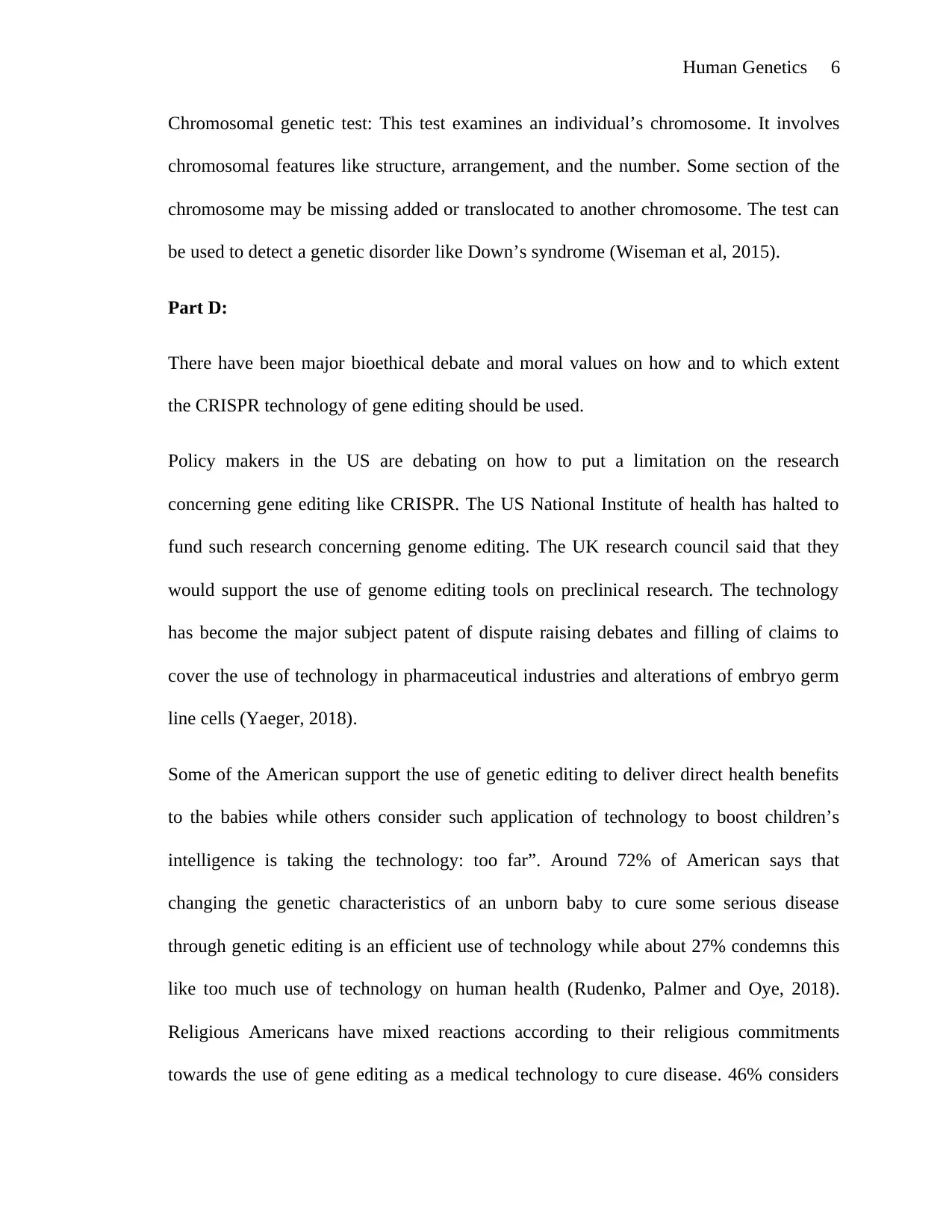
Human Genetics 6
Chromosomal genetic test: This test examines an individual’s chromosome. It involves
chromosomal features like structure, arrangement, and the number. Some section of the
chromosome may be missing added or translocated to another chromosome. The test can
be used to detect a genetic disorder like Down’s syndrome (Wiseman et al, 2015).
Part D:
There have been major bioethical debate and moral values on how and to which extent
the CRISPR technology of gene editing should be used.
Policy makers in the US are debating on how to put a limitation on the research
concerning gene editing like CRISPR. The US National Institute of health has halted to
fund such research concerning genome editing. The UK research council said that they
would support the use of genome editing tools on preclinical research. The technology
has become the major subject patent of dispute raising debates and filling of claims to
cover the use of technology in pharmaceutical industries and alterations of embryo germ
line cells (Yaeger, 2018).
Some of the American support the use of genetic editing to deliver direct health benefits
to the babies while others consider such application of technology to boost children’s
intelligence is taking the technology: too far”. Around 72% of American says that
changing the genetic characteristics of an unborn baby to cure some serious disease
through genetic editing is an efficient use of technology while about 27% condemns this
like too much use of technology on human health (Rudenko, Palmer and Oye, 2018).
Religious Americans have mixed reactions according to their religious commitments
towards the use of gene editing as a medical technology to cure disease. 46% considers
Chromosomal genetic test: This test examines an individual’s chromosome. It involves
chromosomal features like structure, arrangement, and the number. Some section of the
chromosome may be missing added or translocated to another chromosome. The test can
be used to detect a genetic disorder like Down’s syndrome (Wiseman et al, 2015).
Part D:
There have been major bioethical debate and moral values on how and to which extent
the CRISPR technology of gene editing should be used.
Policy makers in the US are debating on how to put a limitation on the research
concerning gene editing like CRISPR. The US National Institute of health has halted to
fund such research concerning genome editing. The UK research council said that they
would support the use of genome editing tools on preclinical research. The technology
has become the major subject patent of dispute raising debates and filling of claims to
cover the use of technology in pharmaceutical industries and alterations of embryo germ
line cells (Yaeger, 2018).
Some of the American support the use of genetic editing to deliver direct health benefits
to the babies while others consider such application of technology to boost children’s
intelligence is taking the technology: too far”. Around 72% of American says that
changing the genetic characteristics of an unborn baby to cure some serious disease
through genetic editing is an efficient use of technology while about 27% condemns this
like too much use of technology on human health (Rudenko, Palmer and Oye, 2018).
Religious Americans have mixed reactions according to their religious commitments
towards the use of gene editing as a medical technology to cure disease. 46% considers
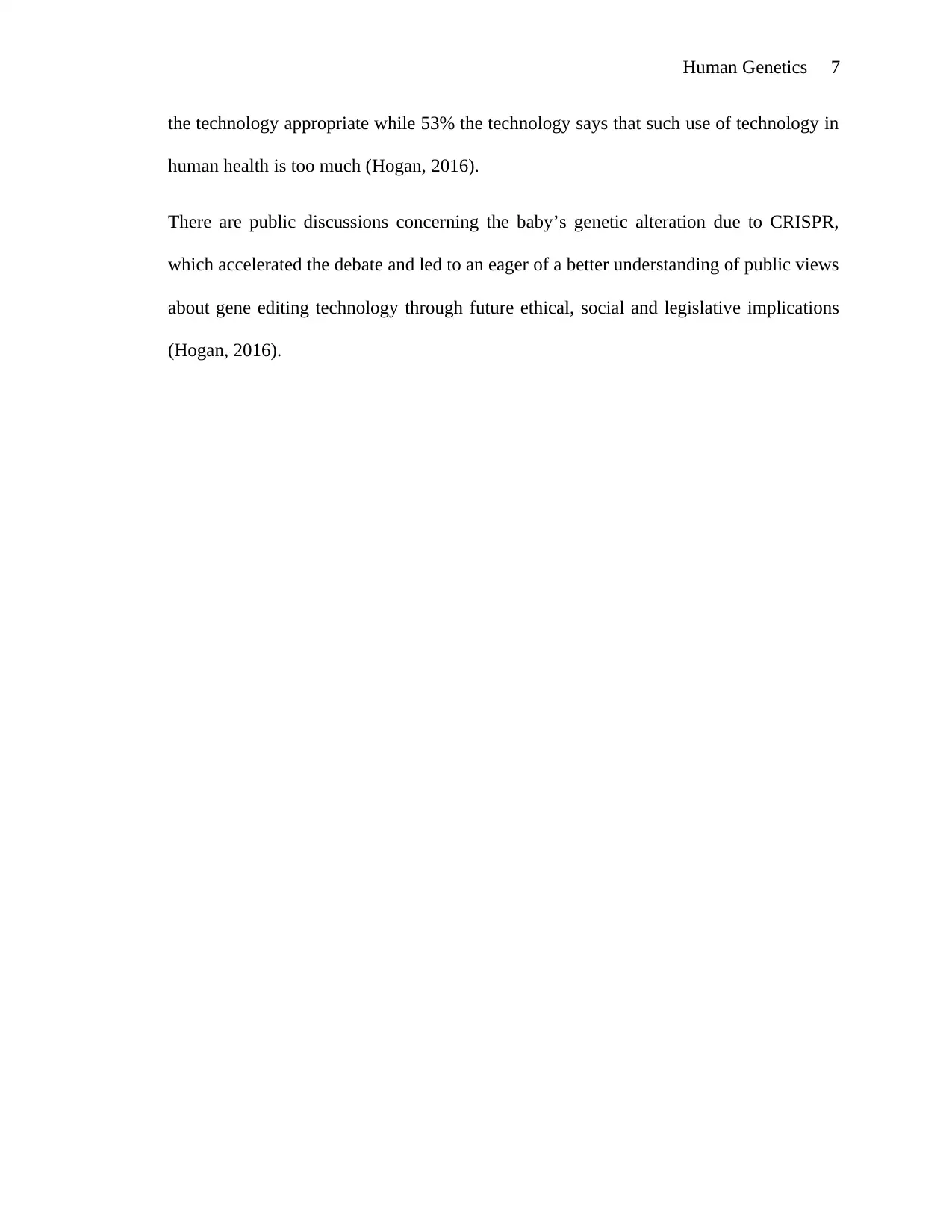
Human Genetics 7
the technology appropriate while 53% the technology says that such use of technology in
human health is too much (Hogan, 2016).
There are public discussions concerning the baby’s genetic alteration due to CRISPR,
which accelerated the debate and led to an eager of a better understanding of public views
about gene editing technology through future ethical, social and legislative implications
(Hogan, 2016).
the technology appropriate while 53% the technology says that such use of technology in
human health is too much (Hogan, 2016).
There are public discussions concerning the baby’s genetic alteration due to CRISPR,
which accelerated the debate and led to an eager of a better understanding of public views
about gene editing technology through future ethical, social and legislative implications
(Hogan, 2016).
Paraphrase This Document
Need a fresh take? Get an instant paraphrase of this document with our AI Paraphraser
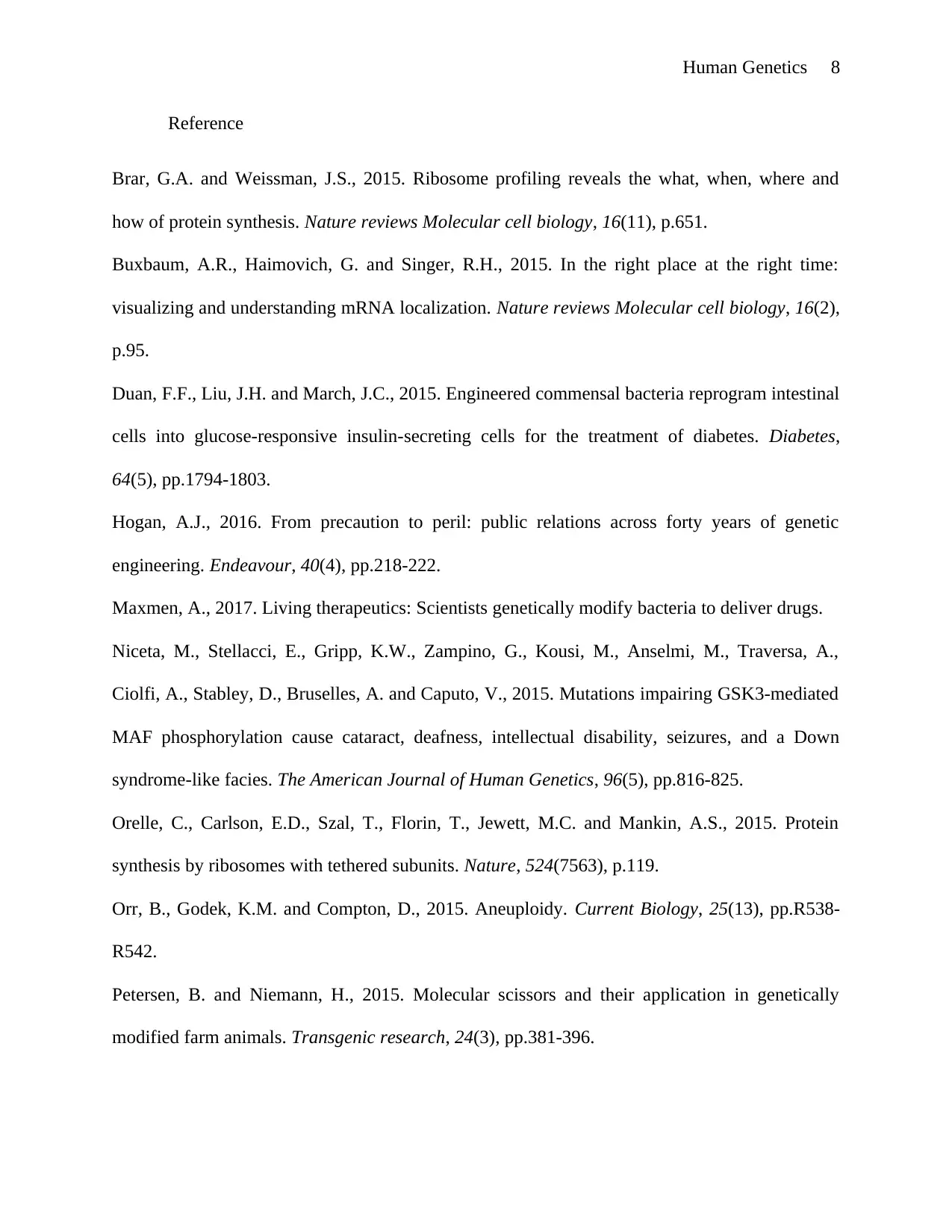
Human Genetics 8
Reference
Brar, G.A. and Weissman, J.S., 2015. Ribosome profiling reveals the what, when, where and
how of protein synthesis. Nature reviews Molecular cell biology, 16(11), p.651.
Buxbaum, A.R., Haimovich, G. and Singer, R.H., 2015. In the right place at the right time:
visualizing and understanding mRNA localization. Nature reviews Molecular cell biology, 16(2),
p.95.
Duan, F.F., Liu, J.H. and March, J.C., 2015. Engineered commensal bacteria reprogram intestinal
cells into glucose-responsive insulin-secreting cells for the treatment of diabetes. Diabetes,
64(5), pp.1794-1803.
Hogan, A.J., 2016. From precaution to peril: public relations across forty years of genetic
engineering. Endeavour, 40(4), pp.218-222.
Maxmen, A., 2017. Living therapeutics: Scientists genetically modify bacteria to deliver drugs.
Niceta, M., Stellacci, E., Gripp, K.W., Zampino, G., Kousi, M., Anselmi, M., Traversa, A.,
Ciolfi, A., Stabley, D., Bruselles, A. and Caputo, V., 2015. Mutations impairing GSK3-mediated
MAF phosphorylation cause cataract, deafness, intellectual disability, seizures, and a Down
syndrome-like facies. The American Journal of Human Genetics, 96(5), pp.816-825.
Orelle, C., Carlson, E.D., Szal, T., Florin, T., Jewett, M.C. and Mankin, A.S., 2015. Protein
synthesis by ribosomes with tethered subunits. Nature, 524(7563), p.119.
Orr, B., Godek, K.M. and Compton, D., 2015. Aneuploidy. Current Biology, 25(13), pp.R538-
R542.
Petersen, B. and Niemann, H., 2015. Molecular scissors and their application in genetically
modified farm animals. Transgenic research, 24(3), pp.381-396.
Reference
Brar, G.A. and Weissman, J.S., 2015. Ribosome profiling reveals the what, when, where and
how of protein synthesis. Nature reviews Molecular cell biology, 16(11), p.651.
Buxbaum, A.R., Haimovich, G. and Singer, R.H., 2015. In the right place at the right time:
visualizing and understanding mRNA localization. Nature reviews Molecular cell biology, 16(2),
p.95.
Duan, F.F., Liu, J.H. and March, J.C., 2015. Engineered commensal bacteria reprogram intestinal
cells into glucose-responsive insulin-secreting cells for the treatment of diabetes. Diabetes,
64(5), pp.1794-1803.
Hogan, A.J., 2016. From precaution to peril: public relations across forty years of genetic
engineering. Endeavour, 40(4), pp.218-222.
Maxmen, A., 2017. Living therapeutics: Scientists genetically modify bacteria to deliver drugs.
Niceta, M., Stellacci, E., Gripp, K.W., Zampino, G., Kousi, M., Anselmi, M., Traversa, A.,
Ciolfi, A., Stabley, D., Bruselles, A. and Caputo, V., 2015. Mutations impairing GSK3-mediated
MAF phosphorylation cause cataract, deafness, intellectual disability, seizures, and a Down
syndrome-like facies. The American Journal of Human Genetics, 96(5), pp.816-825.
Orelle, C., Carlson, E.D., Szal, T., Florin, T., Jewett, M.C. and Mankin, A.S., 2015. Protein
synthesis by ribosomes with tethered subunits. Nature, 524(7563), p.119.
Orr, B., Godek, K.M. and Compton, D., 2015. Aneuploidy. Current Biology, 25(13), pp.R538-
R542.
Petersen, B. and Niemann, H., 2015. Molecular scissors and their application in genetically
modified farm animals. Transgenic research, 24(3), pp.381-396.
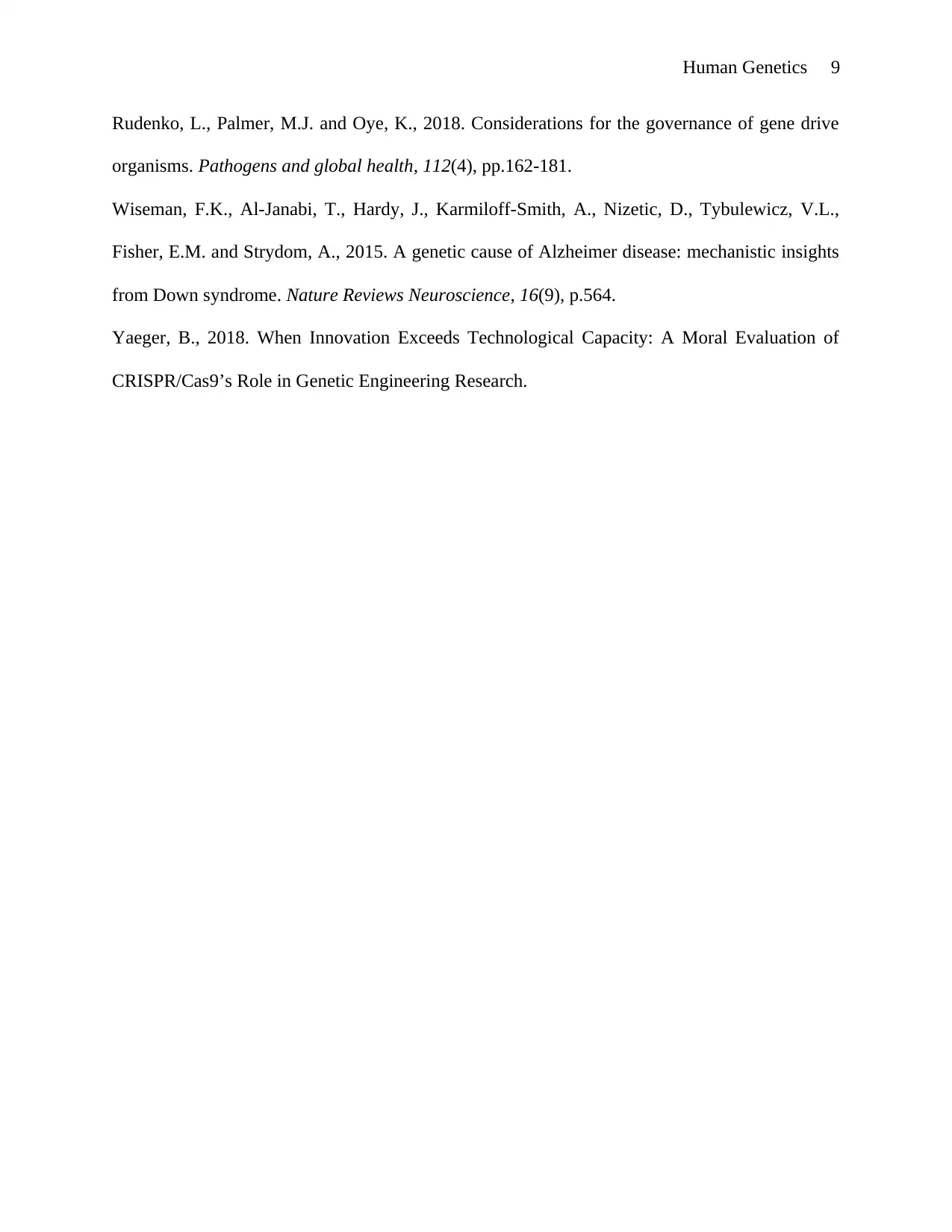
Human Genetics 9
Rudenko, L., Palmer, M.J. and Oye, K., 2018. Considerations for the governance of gene drive
organisms. Pathogens and global health, 112(4), pp.162-181.
Wiseman, F.K., Al-Janabi, T., Hardy, J., Karmiloff-Smith, A., Nizetic, D., Tybulewicz, V.L.,
Fisher, E.M. and Strydom, A., 2015. A genetic cause of Alzheimer disease: mechanistic insights
from Down syndrome. Nature Reviews Neuroscience, 16(9), p.564.
Yaeger, B., 2018. When Innovation Exceeds Technological Capacity: A Moral Evaluation of
CRISPR/Cas9’s Role in Genetic Engineering Research.
Rudenko, L., Palmer, M.J. and Oye, K., 2018. Considerations for the governance of gene drive
organisms. Pathogens and global health, 112(4), pp.162-181.
Wiseman, F.K., Al-Janabi, T., Hardy, J., Karmiloff-Smith, A., Nizetic, D., Tybulewicz, V.L.,
Fisher, E.M. and Strydom, A., 2015. A genetic cause of Alzheimer disease: mechanistic insights
from Down syndrome. Nature Reviews Neuroscience, 16(9), p.564.
Yaeger, B., 2018. When Innovation Exceeds Technological Capacity: A Moral Evaluation of
CRISPR/Cas9’s Role in Genetic Engineering Research.
1 out of 9
Related Documents
Your All-in-One AI-Powered Toolkit for Academic Success.
+13062052269
info@desklib.com
Available 24*7 on WhatsApp / Email
![[object Object]](/_next/static/media/star-bottom.7253800d.svg)
Unlock your academic potential
© 2024 | Zucol Services PVT LTD | All rights reserved.





